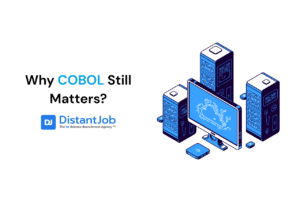Who doesn’t need a new talented addition to grow a software development team? Everyone does. However, how do youmeasure KPIs in software development? Building a great team isn’t enough to ensure the best productivity and outcomes. In addition to talented candidates, you need software and strategies to measure your team’s work and find the best strategy to grow your company.
What Is KPI in Software Development?
When we started at DistantJob, calculating our remote team’s effort was the first step to get the best results with simple and effective tasks – the ill-famed KPI. To understand how much your company is producing, a system to visualize your team’s effort and success is necessary. Especially in a remote work environment.
By definition, a Key Performance Indicator (KPI) is a measurable value to determine the success or failure of various campaigns and business goals. What does it mean in software development?
Development teams follow a process commonly known as SDLC, Software Development Life Cycle. These processes are more frameworks than models. The most popular are Waterfall, V-Shaped, Iterative Development, Spiral, and Agile. There are several steps in all these approaches that each team adapts to their project and goals.
First, make sure there is good communication between your developers and your team. That’s even more important than the model you choose. After that, you have different approaches to monitor and improve your team productivity. Just remember that it is a process, and testing other solutions could be a necessary step.
How do You Measure Software Development Performance?
As a remote company, we genuinely care about team dynamics. We have been testing different strategies through our experience. In the end, we always concluded that strict surveillance isn’t always the best shot. Trust is a much better currency, especially for remote teams. As much as you can calculate KPIs and structure tasks, you can’t schedule human psychology.
So, remember that a lot of what you need to do to measure your software developer performance will be subjective. Sure, you can rely on data points such as code lines, working hours, and bugs. Still, these calculations might give a false impression of productivity.
Before looking at data, look at the person you hired. Engagement and attention to quality can tell you more than software for productivity. If your developer is dedicated to your project and very careful in testing before the delivery, you know you are working with the right person. Plus, remember we are talking of developers. New programming languages come up every month with even more frequent updates. JavaScript frameworks are blooming like flowers in spring.
There is a reason why developers’ employment is in exponential growth. It is because the tech world is in constant, and fast, evolution. If you want to be on top of businesses, you can’t miss the latest tech fancy gadget. And so does your developer. Make sure to pick someone who is always happy in learning new skills and new technologies. You will need someone innovative as you are to make your dreams real.
Last but not least, mind personal responsibilities. How does your developer react after making a mistake? How does he/she handle your team’s feedback? These are all subjective points, yet fundamental to understand the data your final evaluation will show.
Here Are The Best Developer Performance Metrics
With that said, to measure software development performance intuition isn’t your only ally. Especially in remote teams, these are some tools to get a fair overview of your developer productivity.
Cycle Time: It measures how long takes to move from one status to another for a bug, a feature, or a task. Focussing on speed and productivity, cycle time can tell you where your project’s blockers or breakdowns are, helping the communication between your team and developers.
Sprint Burndown: This one makes your team’s work visible with a ‘graphic representation of the rate at which work is completed and how much work remains to be done.’ As a graphic representation, you have the work done on the y-axis and the time spent on the x-axis. Like the graphs you were doing a school, remember? With this metric, it is easy to visualize if your team is running in time and how to split tasks to avoid future burnouts.
Velocity: With this tool, you can measure the ‘delivered value’ of your development team by looking at the number of features completed within a set period and ready to test. This system calculates productivity based on each team’s specific estimation culture. Basically, your velocity is only yours and cannot be compared with other teams. Velocity helps you to set realistic expectations, predict future challenges and understand when your team is stuck with something. Just remember, if your velocity metric doesn’t stabilize in a few weeks, then there is something wrong with your software developers’ performance.
Open Requests: It is about the requests your team is missing or not addressing efficiently. If one of your developers pulls a request and your team cannot provide feedback, then you have a bottleneck to solving. This system helps you isolate what is missing and re-allocate tasks and responsibilities accordingly.
Throughput: This one measures the total work output, including features, tasks, bugs, and what is ready to test. Tracking your team over time, this tool allows you to align goals and synchronize your teamwork.
Best Software Development Key Performance Indicator? Hire the Right One!
As we said, tools can help you quantify your team productivity, but they cannot guarantee you that your team will be productive. For that, you need to go back to your intuition. Especially at the very beginning of your project, the hiring process.
At DistantJob, we have learned that choosing the right people is the best way to guarantee productivity. That’s why, for us, the interview process is vital. When you talk with people, you can understand how passionate they are about their job and how much they will be committed to your project.
And that will work better than any software or model. We are experts in remote hiring processes and, with all our experience, we are always happy to share our stories and advice. So, if you still have questions, knock on our (virtual) door. We are here to help! Book a call with us today!






